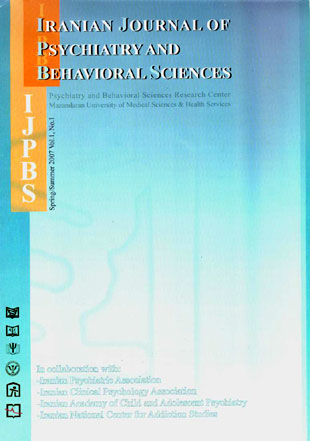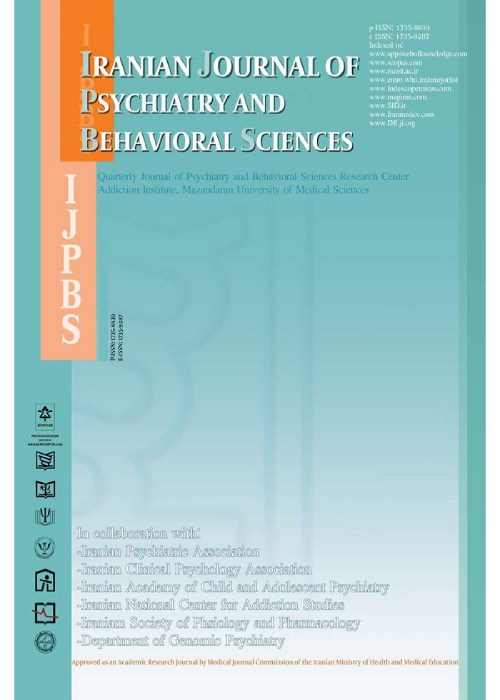فهرست مطالب

Iranian Journal of Psychiatry and Behavioral Sciences
Volume:1 Issue: 1, Jul 2007
- تاریخ انتشار: 1386/05/11
- تعداد عناوین: 12
-
-
EditorialPage 1
-
Page 2General population surveys often report that only a small proportion of individuals with common mental disorders seek mental health treatment, suggesting a high level of unmet need for mental health care in the community. In recent years, however, the number of adults in industrialized countries who are treated with antidepressant medications has dramatically increased. This paper reviews the public health impact of the increase in the use of antidepressant medications. Whereas some studies suggest a decrease in the incidence of suicide corresponding with the increase in the use of antidepressant medications, other studies do not report such an association. Furthermore, there has been no change in the period prevalence of common mental disorders concurrent with the increase in the use of antidepressant medications. Focusing effort and resources on expanding the capacity of mental health services and improving access to these services without attention to quality, intensity and appropriate targeting of treatments may have limited impact on the mental health of populations.
-
Page 7ObjectiveDespite the discovery of new antipsychotic drugs in recent years, a number of schizophrenic patients show no response to such drugs and are considered treatment-resistant. In such cases, clozapine and occasionally ECT or a combination of drugs are used, though they are not very effective. In recent years, the combination of clozapine and ECT for treatment-resistant schizophrenic patients has been suggested; the results of preliminary studies have been hopeful. Te aim of this study was to compare the results of treatment with clozapine alone, ECT alone, and the combination of clozapine with ECT in treatment-resistant schizophrenic patients.MethodEighteen treatment-resistant schizophrenic patients were assigned to three equal groups: one group was given clozapine; one group was treated with ECT; and one group was treated with the combination of clozapine and ECT. The treatment response was evaluated using the PANSS criteria, and the data were analyzed with ANOVA.ResultsCombination therapy was superior to single modality therapy. The reduction of PANSS scores was 46% in the clozapine group, 40% in the ECT groups, and 71% in the combination group; the difference between the combination group and the other groups was statistically significant (P<0.05). Patients had a quick response to combination treatment, which resulted in a higher cure rate of positive and negative symptoms and improved the patients’ general performance. There were no significant adverse effects with combination treatment.ConclusionCombination treatment with clozapine and ECT was safe and effective in treatment-resistant schizophrenic patients. It should be considered for the treatment of treatment-resistant schizophrenic patients.
-
Page 12ObjectiveAlthough sodium valproate came to the market as an anticonvulsant drug, nowadays it''s wildly used in the management of psychiatric disorders. It is used as a mood stabilizer and as an adjunctive agent in treatment of depression and psychosis. There are controversies regarding sodium valproate efficacy in psychosis. Although some studies have reported that it is effective in the management of positive symptoms and aggression in acute psychosis, others have not found such an association. Our study aims to investigate the effects of adjunctive sodium valproate in the pharmacological management of patients with schizophrenia.MethodIn a double blind clinical trial, 32 schizophrenic patients (age 18 – 65), who were in immediate need of admission, were randomly allocated into two groups. The first group was treated by combination of sodium valproate and risperidone and the other by combination of placebo and risperidone. A diagnosis of schizophrenia was established based on DSM-IV-TR criteria. All patients were assessed by PANSS on the 1st, 14th and 28th days of the admission. The collected data were analyzed by Student and Paired T tests through SPSS.ResultsComparison of PANSS mean score in two groups, before and after the trial, showed statistically significant differences. The reduction in PANSS score was significantly higher in the group treated with sodium valproate than in placebo group (P= 0.006). Although, there was a statistically significant reduction in positive symptoms in both group after 2 weeks of treatment (P= 0.048), the difference was not significant in the fourth week (P= 0.88).ConclusionOur study shows that if used as an adjunct to antipsychotic in the management of acute psychosis, sodium valproate will speed up the recovery of positive symptoms.
-
Page 16Objective
In spite of introduction of novel drugs, Obsessive-Compulsive Disorder (OCD) has still found no suitable treatment. On the other hand, high rates of co-morbidity of OCD with bipolar spectrum disorders are increasingly recognized. Mood switching and development of rapid cycling with antidepressants are significant problems in these patients. From this viewpoint, introducing a non-antidepressant anti-OCD drug has great theoretical and clinical importance. In this open-label clinical trial we evaluated the effects of naltrexone on OCD symptoms.
MethodIn this study, 23 OCD outpatients treated with a fixed dose of clomipramie, fluoxetine, or both, for at least 3 months before trial underwent treatment with naltrexone, 25 to 100 milligrams a day as adjunctive treatment. Change in symptoms was evaluated by Yale-Brown Obsessive-Compulsive Scale (YBOCS), Persian version, administered at baseline and at the end of the 2 months trial.
ResultsSeven patients dropped out of the study before the end of the 2 months: 4 patients for non-response and 3 patients for intolerable side effects. Sixteen patients, 9 females and 7 males, completed the study. The most frequent co-morbid disorders found in these patients were bipolar spectrum disorders (68.7%). Non-parametric (Wilcoxon Signed Ranks Test) and parametric (paired t-test) analyses both showed significant reductions in YBOCS ratings after naltrexone treatment (P<0.001). Two patients remained symptom free over 6 months after discontinuation of all medications.
ConclusionAlthough small sample size and open design of the trial make the results tentative, it appears that naltrexone may be effective on at least certain subgroups of OCD patients, especially those with both OCD and bipolar spectrum disorders. Long-term effects of the drug after discontinuation should be addressed in future double-blind studies
-
Title: Serum Lipid Concentrations in Iranian Veterans with Combat-Related Chronic Posttraumatic Stress DisorderPage 22Objective
Numerous Iranian veterans who took part in Iraq-Iran war have developed post traumatic stress disorder (PTSD). Several studies demonstrated changes in serum lipid concentrations in chronic PTSD (cPTSD) patients. The purpose of this study was to assess serum lipid concentrations in soldiers with cPTSD and compare it with serum lipid concentrations in patients with chronic MDD (cMDD).
MethodWe measured serum lipid concentrations in patients diagnosed with cPTSD (n=40) and cMDD (n=40) and compared the results. Patients were diagnosed based on DSM-IV TR criteria. The patients were all male (30-48 years old) and had an illness history of more than 2 years prior to conducting the study. The groups were matched regarding their body mass index (BMI) and duration of symptoms. Laboratory investigations and psychiatric evaluations were carried-out 5 days after admission. Serum lipid concentrations were measured by enzyme assay (EA) immediately after taking the samples with commercial kits (pars-Azmon, Iran).
ResultscPTSD group showed significantly greater mean cholesterol concentrations (227.3 ± 69.7 mg/dL) than the cMDD group (190.7 ± 35.4 mg/dL) (P=0.004). Mean high density lipoprotein cholesterol (HDL-C) concentrations for cPTSD patients (66.6 ± 17.6 mg/dl) was significantly lower than HDL-C level in cMDD patients (76.5 ± 19.7 mg/dL) (P= 0.02). In contrast, mean low density lipoprotein cholesterol (LDL-C) concentrations for cPTSD patients (118.9 ± 60.1 mg/dL) was significantly higher than LDL-C level in cMDD patients (76.5 ± 25.2 mg/dL) (student t-test; P= 0.000). Although similar differences was noticed on triglycerides concentration between two groups (cPTSD; 220.2 ± 79.0 and cMDD; 201.0 ± 61.8), it was statistically non-significant (P= 0.23).
ConclusionOur findings suggest that cPTSD patients are at high risk of developing arteriosclerosis and vascular incident secondary to low levels of HDL-C and high levels of LDL-C
-
Page 27ObjectiveIn Aug 2004, for the first time, a psychiatric OSCE was piloted in Iran. The objective of current study was to explore the view and opinion of both candidates and examiners after they took part in the exam.MethodTwo focus groups were formed. There were 10 participants in each group. Each group was asked to discuss the advantages and disadvantages of the OSCE. The discussion was tape recorded and then converted into a script before being analyzed.ResultsStandard format of the exam and its unbiased evaluation of candidates’ abilities were reported as the most significant advantages of OSCE. However, participants criticized the artificiality of the setting and use of simulated patients.ConclusionAlthough expensive and time consuming to organize, OSCE was viewed as a standard and fair method of assessing candidates’ skills. To overcome the artificiality of the setting, participants asked for a better training of the actors and actresses.
-
Cigarette Smoking among Iranian AdolescentsPage 30ObjectiveSmoking is a worldwide health problem. Despite recent efforts to reduce the rate of smoking, adolescent smoking still remains a significant public health concern.Current study was conducted to determine the effects of socio-environmental and personal factors on the smoking among adolescents.MethodIn the first stage of a longitudinal study of smoking in adolescents, 1785 students in Tabriz city were randomly selected. A self-administered questionnaire was used to collect information about demographic characteristics and self-esteem of the subjects and their attitude towards smoking. Information was also gathered about the smoking habits of the subjects, their families and friends. The association of different variables with smoking was evaluated by a logistic regression model and Chi square test using SPSS.ResultsMean age of the subjects was 16.3 ± 0.87 years. 77.4% of them reported that they never smoked. 18.2% had experimented the cigarette smoking at least once. But 4.4% said that they were regular smokers. Having a smoker family member (OR=1.40) or a smoker friend (OR=3.43) and a positive attitude toward smoking (OR=1.23) were significantly associated with a higher prevalence of smoking.ConclusionAn educational program aimed at changing the attitude towards smoking may be a successful primary prevention method.
-
Idiopathic Basal Ganglia Calcification with Bipolar Mood Disorder PresentationPage 36
-
Excerpts from Psychiatric LiteraturePages 43-50


